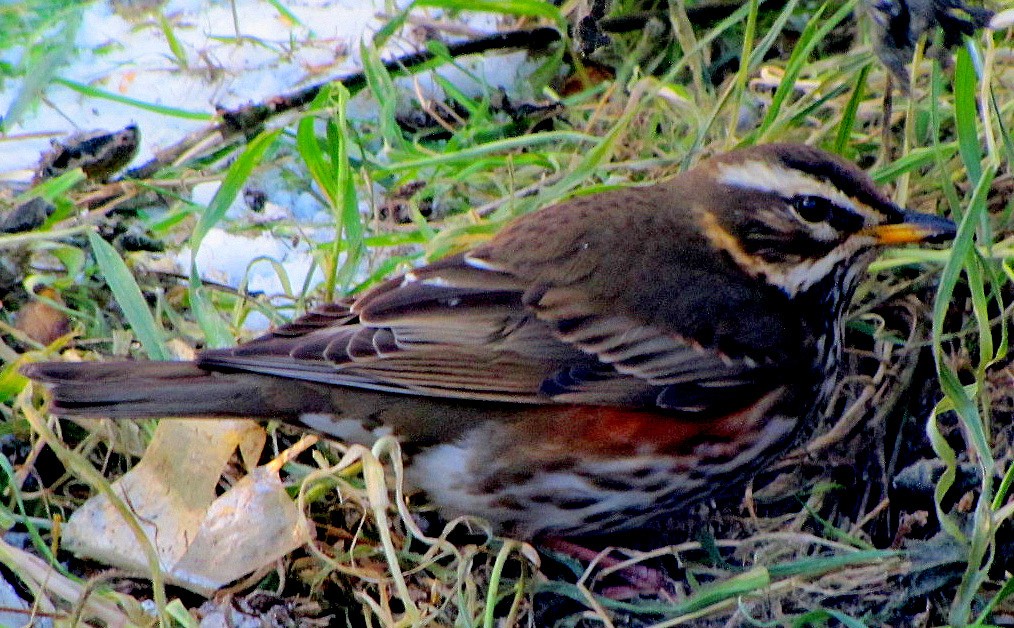Redwing
A species of True thrushes Scientific name : Turdus iliacus Genus : True thrushes
Redwing, A species of True thrushes
Botanical name: Turdus iliacus
Genus: True thrushes
Content
Description People often ask General Info
Description
It is 20–24 cm long with a wingspan of 33–34.5 cm and a weight of 50–75 g. The sexes are similar, with plain brown backs and with dark brown spots on the white underparts. The most striking identification features are the red flanks and underwing, and the creamy white stripe above the eye. Adults moult between June and September, which means that some start to replace their flight feathers while still feeding young. The male has a varied short song, and a whistling flight call. 
Size
21 cm
Colors
Brown
Gray
White
Orange
Life Expectancy
19 years
Nest Placement
Shrub
Feeding Habits
Redwing's diet is omnivorous, including insects, earthworms, and berries, particularly from rowan and hawthorn. Its foraging is year-round, with seasonal berry consumption.
Habitat
The redwing's environment encompasses forest-open country mosaics and primarily occupies mid-successional river basins, as well as lowland deciduous or mixed woods with clearings. Breeding habitats include tundra scrub in more northern locales. Adapted to semi-open cultivated areas, it also resides in urban parks and gardens. In winter, it prefers open woodlands, orchards, and scrubland, often adjacent to grasslands, expanding into city landscapes during severe weather.
Dite type
Omnivorous
People often ask
General Info
Feeding Habits
Bird food type
Bird Feeder Type

Ground

Platform
Sounds
Call
Recording location: Belgium
Song
Recording location: Belgium
Call
Recording location: Netherlands
Behavior
Migrating and wintering birds often form loose flocks of 10 to 200 or more birds, often feeding together with fieldfares, common blackbirds, and starlings, sometimes also with mistle thrushes, song thrushes, and ring ouzels. Unlike the song thrush, the more nomadic redwing does not tend to return regularly to the same wintering areas. 
Distribution Area
It breeds in northern regions of Europe and the Palearctic, from Iceland south to northernmost Scotland, and east through Scandinavia, the Baltic States, northern Poland and Belarus, and through most of Russia to about 165°E in Chukotka Autonomous Okrug. In recent years it has expanded its range slightly, both in eastern Europe where it now breeds south into northern Ukraine, and in southern Greenland, where the Qaqortoq area was colonised in 1990–1991. It is often replaced by the related ring ouzel in areas of higher altitude. It is migratory, wintering in western, central and southern Europe, north-west Africa, and south-west Asia east to northern Iran. Birds in some parts of the west of the breeding range (particularly south-western Norway) may be resident, not migrating at all, while those in the far east of the range migrate at least 6,500–7,000 km to reach their wintering grounds. There are multiple records of vagrants from the north-east coast of North America, as well as two sightings on the north-west coast (one in Washington in 2005, and one in Seward, Alaska in November 2011). 
Species Status
The redwing has an extensive range, estimated at 10 million square kilometres (3.8 million square miles), and an estimated population of 26 to 40 million individuals in Europe alone. The European population forms approximately 40% of the global population, thus the very preliminary estimate of the global population is 98 to 151 million individuals. The species is believed to approach the thresholds for the population decline criterion of the IUCN Red List . 
Scientific Classification
Phylum
Chordates Class
Birds Order
Perching birds Family
Thrushes Genus
True thrushes Species
Redwing 